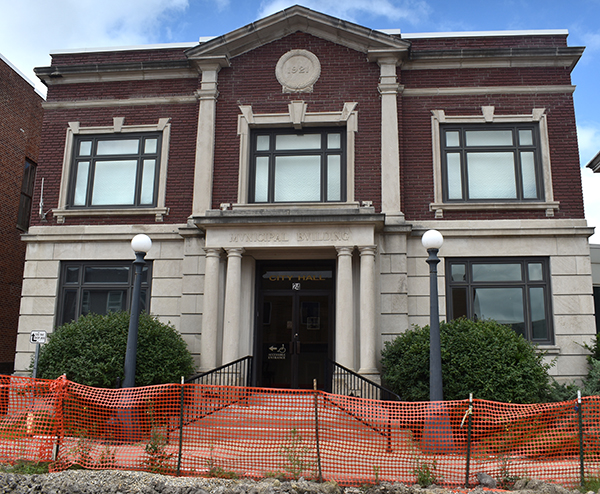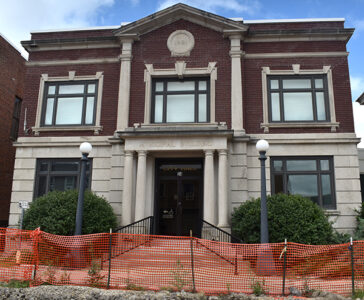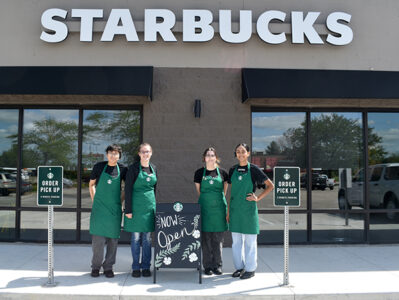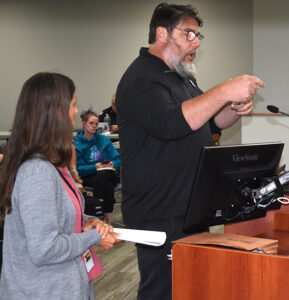Council discusses future of city building at 24 N. Center St.
Vacating, selling floated as possibility

T-R PHOTO BY ROBERT MAHARRY During Monday night’s meeting, the Marshalltown city council discussed options for the future of the city hall building at 24 N. Center St., which was constructed in 1921 and houses eight employees — the city administrator, city clerk, Human Resources director and five members of the finance department. It is currently connected to the larger and newer city building at 10 W. State St.
As part of the final discussion item on Monday night’s agenda, the Marshalltown city council engaged in a conversation about potential HVAC improvements at the older of two buildings that make up Marshalltown’s city hall — the Carnegie structure constructed in 1921 and located at 24 N. Center St. — and discussed several potential options, including vacating the premises and selling it.
According to Public Works Director Heather Thomas, there are eight employees currently working on the main floor at 24 N. Center — City Administrator Carol Webb, Human Resources Director Jill Petermeier, City Clerk Alicia Hunter and five people in the finance department — but the second floor and the basement are essentially unused other than for miscellaneous storage and a server room. She said a study was commissioned based on concerns from staff members and the age of the infrastructure for the mechanical systems in that building, and a needed repair to the boiler system was completed recently. The current heating system is a steam boiler shared with 22 N. Center St., the former police station that now houses YSS of Marshall County, and the city building has several cooling units of its own.
The study identified that the building’s heating system is 30 years old, and more than 80 percent of its current cooling capacity is over 50 years old with no ventilation air. The efficiency for the boiler and cooling system are also well below modern standards.
Thomas then presented a series of options.
1. Just looking at the heating system and installing the city’s own dedicated steam boiler at an estimated cost of $217,000, with nothing done on the cooling system.
2. Replacing the cool only system using the forced air ducts there today with a cool heat system and adding ventilation at a cost of $382,000.
3. Similar to option two but adding heat pumps to increase efficiency at a cost of $522,000.
The fourth option, which Thomas acknowledged would likely be controversial, would be moving the eight employees to other workspaces, severing 24 N. Center St. from the newer city hall building at 10 W. State St. and discontinuing its use as a city facility. Various other necessary improvements to the building could cost another $300,000 over five years, Thomas said.
“One of the broader level, high level picture questions as we talk about HVAC is ‘Does continued ownership and maintenance of this building for eight city staff make financial sense?’ And so what I’m looking for this evening is direction for city staff to continue pursuing HVAC improvements, and if so, at what time and what option, or if there is another direction you would like city staff to continue looking,” she said.
Councilor Gary Thompson quickly asked how long it would take the current staff to move out of the building if they did choose to pursue the fourth option and put it out for Requests for Proposals (RFPs). Thomas responded that there would be several steps involved, including the disconnection from the State Street building and moving/digitizing old records stored at 24 N. Center, so it probably wouldn’t happen within the next month or even the next year.
Thompson then expressed his support for the final option, and fellow Councilor Greg Nichols asked about the process of scanning and digitizing the aforementioned records. Councilor Mark Mitchell concurred with Thompson and felt it would save taxpayers “quite a little bit of money,” and Councilor Jeff Schneider said he didn’t think there were any opportunities to move other employees into the building to optimize its use. He also sought more information on cost savings and capital expenditures to separate the building.
Councilor Barry Kell expressed shock that a study for HVAC led to a conversation about potentially vacating a historic city building.
“I understand where we are and why we’re doing this, but we spent quite a bit of money for a study to tell us we knew this was gonna be expensive, and now it’s ‘Do we even want to occupy this building?’ I don’t know. The sequence strikes me as strange, but I think there’s more information we need to have to make a proper evaluation,” he said.
Schneider then asked about mini splits, and Thomas responded that a mini split was included in a certain area for options two and three, but not in each individual office. She predicted that the $382,000 option would be less expensive than a mini split for each individual room, and Thompson then jokingly asked how much it would cost to buy Hunter a fan and a jacket.
In response to Kell, Thomas said there had been previous discussions about the future of the building in 2022 before it got to the HVAC stage, and the city administrator position has turned over twice since then. Kell also asked about the feasibility of soliciting bids on the HVAC projects to see if they come back higher or lower than estimates, and Councilor Melisa Fonseca sought clarity on what part of the building would be vacated by staff in the event of a closure.
Thomas said the ramp between the two buildings near where the Housing and Community Development staff works would be the point of disconnection. Fonseca worried about passing the problems on to a new building owner and advocated for maintaining and improving real estate.
“If we’re the best ones to be using the property and, you know, maybe repurposing different areas of it, then I think that’s what we should do. And maintaining and doing the updates is crucial to the longevity of that building, and I think that’s what we should do,” Fonseca said.
During the public comment period, Leigh Bauder said she liked option four and wondered if YSS could potentially purchase the adjacent building and use it to address the homelessness issue in Marshalltown, and Mayor Pro Tem Mike Ladehoff replied that those conversations would likely not begin until the council formally decided to move forward with vacating the building.
Dave Grieve expressed concern about putting another building up for sale in the downtown area, calling it “a tough sell” considering the potential cost of the improvements to make it viable for other uses.
“I’m more in favor of trying to save old buildings, and since you own it, maybe find a better way to fix it. I agree with you that these studies are almost worthless. They just introduce questions that don’t get answered, but I hate to see another building sit empty waiting for somebody to throw a half a million (dollars) just to make it viable,” he said.
Lonnie Hogeland also opposed the idea of selling the building and hoped city leaders would pay the necessary cost to fix it but suggested choosing YSS if it is sold. Jim Shaw sought clarification on the connection between the two city buildings, and Erin Carpenter implored the council to consider sustainability, climate readiness and “doing things right,” sharing her preference for option three if the council chooses to keep the property.
Marco Yepez Gomez agreed with Hogeland that the building should be preserved, and he worried about the area becoming desolate if more downtown structures are vacated. He did, however, also express support for the idea of a homeless shelter.
“I don’t think it’s gonna get bought up if it doesn’t have HVAC. I don’t know, it just kind of saddens me that it’s gonna be abandoned or it’s gonna add to this broken windows (aesthetic) that some areas here in town are heading towards,” he said.
The council took no official action, and the meeting was adjourned.
——
Contact Robert Maharry
at 641-753-6611 ext. 255 or
rmaharry@timesrepublican.com.




